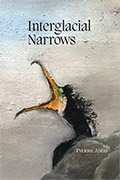- Next story 2 Videos of Jerome Rothenberg being filmed by Pascual Bozelli
- Previous story Sausage Kulchur
Events
Reading
STAND4 Gallery: Karstic-Action VOTE 2024!
STAND4 Gallery, 414 78th Street, Bay Ridge, Brooklyn, New York 11209
Adeena Karasick, Pierre Joris & Nicole Peyrafitte
A Tribute to Tyrone Williams
Pierre Joris, Scott Laudati & Nicole Peyrafitte
Jerome Rothenberg (1931-2024) Celebration
Poetry Reading
ABOUT
Pierre Joris, born in Strasbourg, France in 1946, was raised in Luxembourg. Since age 18, he has moved between Europe, the Maghreb & the US & holds both Luxembourg & American citizenship. He has published over 80 books of poetry, essays, translations & anthologies — most recently Interglacial Narrows (Poems 1915-2021) & Always the Many, Never the One: Conversations In-between, with Florent Toniello, both from Contra Mundum Press. In 2020 his two final Paul Celan translations came out: Microliths They Are, Little Stones (Posthumous prose, from CMP) & The Collected Earlier Poetry (FSG). Forthcoming are: Paul Celan’s “Todesfuge” (Small Orange Import, 2023) & Diwan of Exiles: A Pierre Joris Reader (edited with Ariel Reznikoff, 2024). For a full list see the right column on this blog.
In 2011 Litteraria Pragensia, Charles University, Prague, published Pierre Joris: Cartographies of the In-between, edited by Peter Cockelbergh, with essays on Joris’ work by, among others, Mohammed Bennis, Charles Bernstein, Nicole Brossard, Clayton Eshleman, Allen Fisher, Christine Hume, Robert Kelly, Abdelwahab Meddeb, Jennifer Moxley, Jean Portante, Carrie Noland, Alice Notley, Marjorie Perloff & Nicole Peyrafitte (2011).
Other work includes the CD Routes, not Roots (with Munir Beken, oud; Mike Bisio, bass; Ben Chadabe, percussion; Mitch Elrod, guitar; Ta’wil Productions). With Jerome Rothenberg he edited Poems for the Millennium, vol. 1 & 2: The University of California Book of Modern & Postmodern Poetry, and with Habib. Tengour Poems for the Millennium, vol. 3: The University of California Book of North African Literature.
When not on the road, he lives in Bay Ridge, Brooklyn, with his wife, multimedia praticienne Nicole Peyrafitte. A volume of their collaborative work, to be called Domopoetics, will be published in the near future.
More
RECENT PUBLICATIONS
BOOKS IN PRINT
 “Conversations in the Pyrenees”
“Conversations in the Pyrenees”
 “An American Suite” (Poems) —Inpatient Press
“An American Suite” (Poems) —Inpatient Press
 “Arabia (not so) Deserta” : Essays on Maghrebi & Mashreqi Writing & Culture
“Arabia (not so) Deserta” : Essays on Maghrebi & Mashreqi Writing & Culture
 “The Agony of I.B.” — A play. Editions PHI & TNL 2016
“The Agony of I.B.” — A play. Editions PHI & TNL 2016
 “The Book of U / Le livre des cormorans”
“The Book of U / Le livre des cormorans”
 “Memory Rose Into Threshold Speech: The Collected Earlier Poetry of Paul Celan”
“Memory Rose Into Threshold Speech: The Collected Earlier Poetry of Paul Celan”
 “Paul Celan, Microliths They Are, Little Stones”
“Paul Celan, Microliths They Are, Little Stones”
“Exile is My Trade: A Habib Tengour Reader” edited & translated by Pierre Joris
“Meditations on the Stations of Mansur al-Hallaj”
“Paul Celan: The Meridian Final Version”—Drafts—Materials
“Pierre Joris: Cartographies of the In-Between” edited by Peter Cockelbergh
“The University of California Book of North African Literature”
4×1 : Works by Tristan Tzara, Rainer Maria Rilke, Jean-Pierre Duprey and Habib Tengour
PABLO PICASSO The Burial of the Count of Orgaz & Other Poems
Poasis (Selected Poems 1986-1999)
Poems for the Millennium 1 & 2
ppppp-Poems Performances Pieces Proses Plays Poetics by Kurt Schwitters


 “Todesguge/Deathfugue”
“Todesguge/Deathfugue” “Interglacial Narrows (Poems 1915-2021)”
“Interglacial Narrows (Poems 1915-2021)” “Always the Many, Never the One: Conversations In-between, with Florent Toniello”
“Always the Many, Never the One: Conversations In-between, with Florent Toniello” “A Voice Full of Cities: The Collected Essays of Robert Kelly.” Edited by Pierre Joris & Peter Cockelbergh
“A Voice Full of Cities: The Collected Essays of Robert Kelly.” Edited by Pierre Joris & Peter Cockelbergh “Barzakh” (Poems 2000-2012)
“Barzakh” (Poems 2000-2012) “Fox-trails, -tales & -trots”
“Fox-trails, -tales & -trots” “Paul Celan: Breathturn into Timestead-The Collected Later Poetry.” Translated & with commentary by Pierre Joris. Farrar, Straus & Giroux
“Paul Celan: Breathturn into Timestead-The Collected Later Poetry.” Translated & with commentary by Pierre Joris. Farrar, Straus & Giroux
At any time during the history of mankind an argument could have been made for global warming and/or extreme weather. That said, at any time during the history of mankind an argument could have been made for global cooling and/or extreme weather. Even before mankind existed, both arguments could easily have been advanced. In fact, in all the above cases, they have been. Weather is like that. It changes. Climate is like that too. It changes, only on a grander scale and over longer periods of time.
The Arctic has always been there in one form or another. For those unfamiliar, the Arctic is an ocean surrounded by land. It is now, of course, frozen over. Arctic winters are long and cold although, surrounded by moderating ocean waters, it is not the coldest place on earth. Antarctica is much colder. Summers are short in the Arctic, and cool. Some parts of the Arctic are covered by sea ice, glacial ice or snow year-round. Virtually all parts of the Arctic are covered by some form of ice for extended periods throughout the year. Winter temperatures can drop below −50 °C (−58 °F) over most of the Arctic. Summer temperatures range from about −10 to +10 °C (14 to 50 °F). A surprise to most, some land areas actually exceed 30 °C (86 °F) in summer occasionally, very occasionally.
Around April or May the eco-warriors will begin to panic as icebergs calf off the Arctic and Greenland and begin floating out to sea. This is not global warming or climate change. It has been a yearly event since, well since before history was recorded. It is a tourist attraction on the east coast of Canada and has been since well, tourist attractions began.
Iceberg Alley is an area stretching from the coast of Labrador to the northeast coast of the island of Newfoundland. The more popular places offer tour boats and kayaks as well as shore vantage points. Places like St. Lewis, Battle Harbour, Red Bay, Point Amour, St. Anthony, La Scie, Twillingate, Fogo Island, Change Islands, Bonavista, St. John’s/Cape Spear, Bay Bulls/Witless Bay, Cape St. Mary’s and St. Vincent’s are accessible by road. Those wee towns on the coast of Southern Labrador can be accessed year round by car ferry from the island of Newfoundland.
If the trip is too far for some North Americans, might I suggest the spectacular ice floes to be found in the more centrally located Niagara River at Fort Erie, Ontario or on Lake Winnipeg, Manitoba each spring. Call ahead for exact dates and times.
Spring and early summer afford the best viewing times on Iceberg Alley but the season does grow longer the further north you go. Icebergs are most plentiful in April and May but are often locked up in sea ice so late May and early June offer the best viewing for those interested in a sight that is not a precursor to the end of days
.
As nature and luck would have it, thousands of whales and millions of seabirds migrate north late in the spring and early summer along Iceberg Alley. Not only do you see a magical display of bergs, you might get to see humpbacks, gannets and puffins altogether in the same place at the same time.
So don’t worry about the Arctic. It has seen it all before. It will again. Wooly Mammoth anyone?